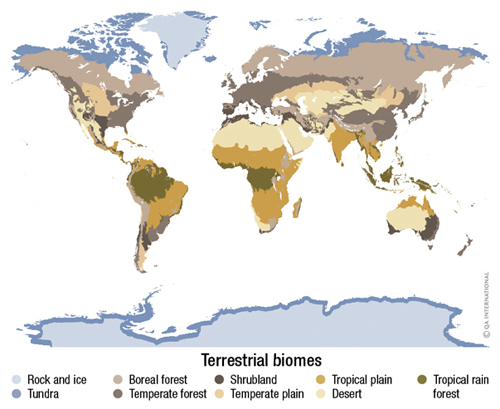
Terrestrial biomes, ecosystems of the planet !
A biome is a large ecological unit subject to specific climatic conditions. It groups together living environments that are sometimes geographically distant from one another, but that share very characteristic vegetation that has adapted to certain sunlight conditions, temperature, precipitation, humidity and wind. The tropical rain forest, temperate forest, boreal forest, plain, savanna, shrubland, desert and tundra are biomes. The word “biome” is often used to designate a terrestrial community, but aquatic communities can also be classified as biomes. Marine biomes include coral reefs and the great ocean depths. Lakes, ponds and watercourses are examples of freshwater biomes. The planet’s principal biomes and the living things that inhabit them are explored in the following chapters. Islands and mountains are not biomes, but their isolation has allowed the development of such exceptional fauna and flora that chapters have been dedicated to them. Artificial habitats, built entirely by humans, are also the subject of a chapter.

Tundra
The tundra is a biome associated with regions that are very cold and arid. Its basic plant formation consists of mosses, lichens and grasses. A few shrubs and dwarf trees can also be found here.
Boreal forest
The boreal forest, also called taiga, is a vast forested expanse mainly consisting of conifers. This biome is subject to long cold winters and short, cool summers.
Tropical rain forest
The tropical rain forest is a dense, green forest that is very rich in biodiversity. The constant heat and humidity that characterize this biome encourage the growth of a multitude of plants.
Temperate forest
The temperate forest mainly consists of broad-leaved trees. This biome is characterized by a variable climate that is rather humid and four distinct seasons. Summers are hot and winters are mild.
Shrubland
The shrubland is a biome characterized by very hot and dry summers, and mild and humid winters. The shrubland mainly consists of persistent-leaved trees that have adapted to summertime drought.
Temperate plain
The temperate plain is practically devoid of trees. Short grasses predominate here. This biome is characteristic of regions with relatively cold and dry winters.
Desert
The desert is a very arid biome characterized by little annual precipitation. The vegetation here is rare and has adapted to the extreme drought conditions, as has the fauna living here.
Tropical plain
The savanna is a tropical plain. This biome, consisting mainly of tall grasses, is dotted with a few trees and shrubs. The savanna is found in hot regions marked by an alternating dry season and rainy season.
Also see:
In the Visual Dictionary:
In the encyclopedic capsules :
- The phenomenon of the seasons
- Configuration of the continents
- Mountains: the top of the world
- Islands, treasure chests of biodiversity
- Earth—the exceptional blue planet
- The coral reefs: a rainbow-colored world
- Shore fauna: vulnerable but tough!
- Infographic: Snowflakes
- The fauna and flora of polar regions: Arctic
- Deserts: where Mother Nature is queen
In the ikonet games:
- Put it in its place!:




